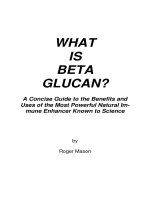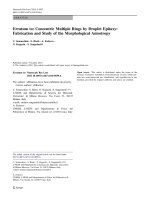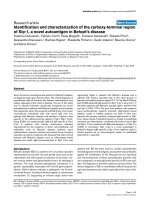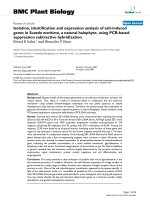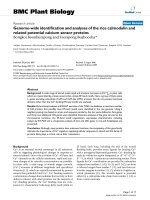Isolation, identification and study of biological characteristics of the pathogenic fungi curvularia lunata causing leaf spot to bananas khóa luận tốt nghiệp
Bạn đang xem bản rút gọn của tài liệu. Xem và tải ngay bản đầy đủ của tài liệu tại đây (1.25 MB, 61 trang )
VIETNAM NATIONAL UNIVERSITY OF AGRICULTURE
FACULTY OF BIOTECHNOLOGY
---------- ----------
GRADUATION THESIS
TITLE:
ISOLATION, IDENTIFICATION AND STUDY OF
BIOLOGICAL CHARACTERISTICS OF THE
PATHOGENIC FUNGI CURVULARIA LUNATA
CAUSING LEAF SPOT TO BANANAS
Hanoi - 2023
VIETNAM NATIONAL UNIVERSITY OF AGRICULTURE
FACULTY OF BIOTECHNOLOGY
---------- ----------
GRADUATION THESIS
TITLE:
ISOLATION, IDENTIFICATION AND STUDY OF
BIOLOGICAL CHARACTERISTICS OF THE
PATHOGENIC FUNGI CURVULARIA LUNATA
CAUSING LEAF SPOT TO BANANAS
STUDENT
: NGO PHUONG HIEN
STUDENT CODE
: 637411
CLASS
: K63-CNSHE
FACULTY
: BIOTECHNOLOGY
MAJOR
: MICROBIOLOGY
INSTRUCTOR
: Ph.D. NGO THU HUONG
Assoc Prof. NGUYEN XUAN CANH
Hanoi - 2023
COMMITMENT
The research was conducted from 9/2022 to 2/2023 under the supervision
of Ph.D. Ngo Thu Huong, Assoc Prof. Nguyen Xuan Canh at Department of
Microbiotechnology – Faculty of Biotechnology – Vietnam National University
of Agriculture.
I hereby declare that the data and results of this study are honest and have
not been published in any scientific research at home or abroad.
References have been clearly cited. Any help during the implementation of
this thesis has been appreciated.
i
i
ACKNOWLEDGEMENTS
Firstly, I want to express my sincere gratitude to all of the Executive
Board, teachers, and lecturers of the Faculty of Biotechnology, Vietnam National
University of Agriculture for helping, encouraging and providing the best working
environment for me to complete the thesis.
Secondly, I would like to express my most sincere thank to Ph.D. Ngo Thu
Huong, Assoc. Prof. Nguyen Xuan Canh for guiding and giving valuable advice
during my research so that I could complete my thesis successfully. Thirdly, I
would like to express my deep gratitude to the lecturers of the Department of
Microbiotechnology, Assoc. Prof. Nguyen Van Giang, Msc. Tran Thi Hong Hanh,
Msc. Nguyen Thanh Huyen, Msc. Tran Thi Dao, Ph.D. student Nguyen Thi Thu
and researcher Duong Van Hoan, Ta Ha Trang for getting me through the
difficulties during my final thesis course. My completion of this project could not
have been accomplished without their devotion.
Last but not least, I crave for expressing my appreciation to my beloved
family members, my friends, and colleagues for their encouragement, motivation
so that I could complete my graduation thesis.
Sincerely,
Hanoi, February 3rd, 2023
Sincerely
Ngo Phuong Hien
ii
CONTENTS
COMMITMENT ...................................................................................................... i
ACKNOWLEDGEMENTS ..................................................................................... ii
CONTENTS........................................................................................................... iii
LIST OF TABLES ................................................................................................. vi
LIST OF FIGURES ............................................................................................... vii
LIST OF ABBREVIATIONS ............................................................................... viii
ABSTRACT........................................................................................................... ix
I. INTRODUCTION.............................................................................................. 1
II. LITERATURE REVIEW ................................................................................. 4
2.1.
Overview of Bananas ................................................................................ 4
2.1.1.
Bananas in food demanding ....................................................................... 4
2.1.2.
Bananas as economic importance ............................................................... 4
2.1.3.
Diseases causing the banana production loss............................................... 5
2.1.3.1. Diseases from bacteria .............................................................................. 5
2.1.3.2. Diseases from virus ................................................................................... 2
2.1.3.3. Diseases from fungi ................................................................................... 3
2.2.
Overview of Curvularia lunata .................................................................. 6
2.2.1.
Overview of Curvularia species ................................................................. 6
2.2.2.
Overview of Curvularia lunata .................................................................. 8
2.2.2.1. Morphology of Curvularia lunata .............................................................. 8
2.2.2.2. Various hosts of Curvularia lunata ............................................................ 9
2.2.2.3. Infection mechanism of Curvularia lunata ................................................ 12
III. MATERIALS AND METHODS ................................................................... 14
3.1.
Time and location for the research ........................................................... 14
iii
3.2.
Materials .............................................................................................. 14
3.3.
Methods ............................................................................................... 15
3.3.1.
Samples collection method ..........................................................................15
3.3.2.
Isolating and subculturing method ......................................................... 16
3.3.3.
Pathogenicity test .................................................................................. 17
3.3.4.
Studying on some biological characteristics of the selected fungi strain... 17
3.3.4.1.
Studying on the morphological characteristics of conidia, mycelium and
conidiophore of the selected fungi strain................................................... 17
3.3.4.2.
Studying on the culturing features of the pathogenic fungi in different medium
............................................................................................................... 18
3.3.4.3.
Screening the ability to produce extracellular enzyme cellulase of the selected
fungi strain .............................................................................................. 18
3.3.5.
Indentification of the selected fungi strain ............................................... 18
3.3.5.1.
DNA extraction method ......................................................................... 18
3.3.5.2.
Amplification, sequencing and analyzing ITS gene sequence of isolated fungi
strain method .......................................................................................... 20
3.3.6.
Screening, detecting toxic genes of fungal strains ..................................... 21
IV. RESULTS AND DISCUSSION ..................................................................... 23
4.1.
Results of samples collection, isolation and subculturing the pathogenic
pathogenic fungi strain. ........................................................................... 23
4.2.
Pathogenicity test ................................................................................... 25
4.3.
Classification of pathogenic fungi strain HN 5.2. ..................................... 26
4.3.1.
Amplification, sequencing and analyzing ITS gene sequence of fungi strain
HN 5.2. ................................................................................................... 26
4.3.2.
Clg2P gene amplification ........................................................................ 29
4.4.
Screening the development of HN 5.2 strain in different medium ............. 29
4.5.
Testing the ability to extract cellulase of HN 5.2 strain .............................. 32
iv
4.6.
Screening for the genes encoding virulence factors biosynthesis in pathogenic
HN 5.2 fungi ........................................................................................... 33
V. CONCLUSION AND PROPOSAL ................................................................. 36
5.1. Conclusion...................................................................................................... 36
5.2. Proposal ......................................................................................................... 36
REFERENCES .................................................................................................... 37
APPENDIX .......................................................................................................... 45
v
LIST OF TABLES
Table 3.1. Virulence factors primer pair sequences ............................................ 21
Table 4.1. Features enumeration and growth comparison of different C. lunata
HN 5.2 fungi media ..........................................................................................................31
vi
LIST OF FIGURES
Figure 2.1. Symptoms ........................................................................................... 4
Figure 2.2. Symptoms of crown rot in banana fruits ............................................ 5
Figure 2.3. Eumusa leaf spot in Southeast Asia.................................................... 6
Figure 2.4. Morphology of Curvularia canadensis with the scale bars = 10μm and
5μm respectively ..................................................................................... 8
Figure 2.5. Conidia of C. lunata CX-3 ................................................................. 9
Figure 2.6. Characteristics of Curvularia leaf spot symptoms on a corn leaf .... 10
Figure 2.7. Leaf spot caused by Curvularia lunata in Aloe vera........................ 11
Figure 4.1. Samples of banana leaves with typical disease symptoms ............... 23
Figure 4.2. The morphology of HN 5.2 fungi strain in PDA medium (with A:
Infected leaves isolation; B and C: Colony morphology of HN 5.2 after
being cultured for 5 days and 8 days respectively; D: HN 5.2 strain
mycelium; E: HN 5.2 strain condiophore; F: HN 5.2 strain conidia. All
of the figures were observed under the magnification of 40X) ............ 24
Figure 4.3. Pathogenicity test of HN 5.2 fungi strain in banana leaves.............. 25
Figure 4.4. Electrophoresis result of ITS gene region PCR product from HN 5.2
fungi strain ............................................................................................ 27
Figure 4.5. Phylogenetic tree based on ITS1/ITS4 sequences of HN 5.2 fungi
strain ...................................................................................................... 28
Figure 4.6. Electrophoresis result for the PCR product of HN 5.2 fungi strain using
P1-F/P2-R primer pair........................................................................... 29
Figure 4.7. The growth and development of C. lunata HN 5.2 colony .............. 30
Figure 4.8. Extracellular cellulase activity of C. lunata HN 5.2 ........................ 33
Figure 4.9. Detecting pathogenic genes in C. lunata HN 5.2 ............................. 35
vii
LIST OF ABBREVIATIONS
Abbriviaions
Full word
C. lunata
Curvularia lunata
MEA
Malt Extract Agar
PDA
Potato Detrose Agar
WA
Water agar
Xcm
Xanthomonas
campestris pv. musacearum
viii
ABSTRACT
This study was conducted with the aim to isolate and identify new
pathogenic agent causing leaf spot on banana. By carrying out experiments
designed and performed under in vitro conditions such as isolating and
subculturing, HN 5.2 strain was successfully isolated from infected banana leaf
samples in Hung Yen province having typical leaf spot disease. Experiments
including observing the morphological features of conidia, mycelium,
conidiophore; doing PCR reaction by using specific fungi primer; ITS sequencing
and making use of bioinformatics tools were taken to identify HN 5.2 strain. The
results stated that HN 5.2 strain is closely related to Curvularia lunata strain and
it was named as Curvularia lunata HN 5.2 strain. C.lunata HN 5.2 biological
characteristics such as the cellulase production ability and culturing conditions
were also tested. Among the medium system, Richard agar medium is the fastest
developmental media. Outstandingly, four out of six virulence factors primers
include HNR-F/HNR-R, Clk1_F/Clk1_R, Clh1_u_F Clh1_u_R and P1-F/P2-R
have been amplified successfully in HN 5.2 strain sequence, providing the
fundamental knowledge for sorting out the pathogenic mechanism of Curvularia
lunata HN 5.2 strain.
ix
I. INTRODUCTION
Banana has been one of the most important staple crops in the world. It
not only plays integral role in demanding food for human beings but also acts
as inevitable economical growth factor in many countries. Bananas are placed
the fourth most important food crop after rice, wheat, and maize by the Food
and Agriculture Organization of the United Nations (Dhankher & Foyer, 2018)
and contribute 15% in the total of 18 billion USD global trade value. In
Vietnam, approximately 1.4 million tons of bananas are planted and produced
yearly per 100,000 hectares making up more than 19% of the entire area of fruit
crops. are proven to be a threat in terms of decreasing fruit yeild and quality
Despite being the important fruit crop, bananas have been become
potential targets for numerous of diseases causing by bacteria, viruses and
fungi for a long time (Dhankher & Foyer, 2018) (Siddiq and Muhammad 2020).
Among those, banana leaf diseases such as popular Sigatoka banana leaf spot
generated by fungal complex Mycosphaerella spp is proven to be a threat in
terms of decreasing fruit yeild and quality seriously (Churchill, 2011).
Nonetheless, new fungi species have been reported to be the factors
causing leaf spot disease recently. Curvularia lunata is a notable fungi species,
having ability to cause leaf spot to various of plants such as aloe vera (Avasthi
et al., 2015); maize (Jimenez Madrid et al., 2022); rice (Kusai et al., 2016).
However, the published scientific reports indicating the infection of C. lunata
in banana plants, especially leaves have been limited. In the world, restricted
countries such as India witnessed and did research on the cases of C. lunata
infection in banana leaves in the recent years (Chowhan & Chakraborty, 2022).
In Vietnam, there have only been published papers about rice plants suffered
from black kernel disease caused by C. lunata (Thủy, 2011)
With the efforts of scientists and the great progress of biotechnology;
leaf spot disease in general can be prevented by physical, chemical and
1
biological methods. The identification of specific pathogenic fungi on bananas
especially leaf spot, which is a fast-spreading disease, will plays important role
in controlling disease. Therefore, the isolation and study of biological
characteristics of the pathogenic C. lunata on bananas has huge impact on
managing banana diseases. In particular, the screening and identification of the
virulent genes of the pathogenic fungal strain is the initial fundament in
studying the pathogenic mechanism of this fungal strain on the novel host at
the molecular level.
As a result, I have carried out the topic: " Isolation, identification and
study of biological characteristics of the pathogenic fungi Curvularia
lunata causing leaf spot to bananas”
Research purpose and content
➢ Research purpose
Determining the causative agent of banana leaf spot disease in a banana
farm in Hung Yen Province based on morphological characteristics and molecular
biological method.
➢ Research content
• Collecting banana leaf samples having typical leaf spot disease
• Isolating and subculturing of fungi strain causing banana leaf spot at
Department of Microbiology, Faculty of Biotechnology, Vietnam National
University of Agriculture.
• Pathogenicity testing on the isolated fungi strain.
• Studying on some biological characteristics of the isolated fungi strain.
• Indentifying the fungi strain using molecular method.
• Screening and detecting virulence genes of the pathogenic fungi strain.
➢ The novelty
This is the first study to confirm Curvularia lunata causing banana leaf
spot disease in Vietnam.
2
➢ The scientific significance
The results of the study are a reference for further studies on the
Curvularia lunata causing leaf spot disease on bananas in Vietnam. These results
could be taken as fundamental information for developing disease control
measurements.
3
II. LITERATURE REVIEW
2.1.
Overview of Bananas
2.1.1. Bananas in food demanding
Following wheat, maize, and rice, banana is the world's fourth most
significant food crop (including plantains). Its importance is noticed not just in
global food demand but also in the global economy growth. Bananas are widely
consumed domestically in many countries, particularly in producing countries,
where they contribute to a significant source of nutrition and food security for
more than 400 million people, according to the Global Market Report in May
2020. There are countless benefits stemming from bananas, demanding essential
nutrients for human beings to survive. A medium banana consists of 422
milligrams of potassium, which is 9% of what humans require on a daily basis.
This mineral has heart-health benefits. Potassium-rich meals help regulate blood
pressure, relax blood vessel walls, reduce the risk of stroke, and avoid kidney
stones in humans. Bananas are also a good source of fiber, particularly soluble
fibers, which help to keep cholesterol levels and blood pressure levels stable.
Regardless, green bananas appear to be an excellent source of vitamins
(C, B6, provitamin A), minerals (magnesium, zinc), bioactive substances such as
phenolic compounds, and resistant starch, which may be found in both the pulp
and peel (Powthong et al., 2020). Banana is a possible carbohydrate source for
food consumption, and its starches have strong resistance to heat and amylase
attack, low swelling qualities, and low retrogradation, making them useful in the
food business as a gelling agent, thickening agent, and stabilizer. Because they
are odorless and soluble, these properties are very significant to the dairy sector.
2.1.2. Bananas as economic importance
According to statistics, bananas are one of the most traded fruits in the
world. In 2017, about 22.7 million tonnes of bananas accounted for almost 20%
of world output. The value of importing and exporting different strains of bananas
reached approximately 11 billion USD, which is more than the export value of
4
any fruit. Among the nations known for their banana consumption, Asia is the
greatest banana-producing geographical region, while Latin America and the
Caribbean are the main exporting areas, accounting for about 80% of worldwide
exports. In 2016, the retail value of the sector was expected to be between $20
billion and $25 billion, providing a living for millions of middle-class individuals
earning their living through planting banana trees(Vivek Voora and Cristina
Larrea 2020).
According to a 2019 study by the Ministry of Agriculture and Rural
Development, bananas represent more than 19 percent of total fruit tree area with
an area of 150,000 hectares and a consumption output of around 2.194 million
tons/year. With this output volume, Vietnam ranks 14th in the globe, accounting
for 1.8 percent of the global market (according to Tridge data). Vietnam's banana
shipments to Russia in 2019 were 919 tons, valued US $ 1.8 million, an increase
of 141.2 percent in volume and approximately 153 percent in value over the same
time in 2018. The average import value of bananas from Vietnam is $1,971.5 per
ton, up 4.8 percent from the previous year. Furthermore, China continues to be
the largest importer of Vietnam's green cavendish banana export capacity. China
purchases from Vietnamese exporting enterprises account for around 15% of
overall import value. China imported over 200,000 tons of bananas from Vietnam
in the first eight months of 2019, valued more than $86 million, an increase of
101.3 percent in volume and 76.7 percent in value over the same time in 2018.
2.1.3. Diseases causing the banana production loss.
2.1.3.1.
Diseases from bacteria
Despite being one of the most integral staple crops, all strains of bananas
have been efected seriously by diseases causing by microorganisms. Several
bacterial diseases, banana Xanthomonas wilt (BXW), caused by Xanthomonas
campestris pv. musacearum (Xcm),
blood
disease,
caused
by Ralstonia
syzygii subsp. celebesensis do harm to banana producing seriously (Tripathi et al.,
2022).
5
•
Xanthomonas wilt: Xanthomonas campestris pv. musacearum
(Xcm) causes Xanthomonas wilt on plants belonging to the Musaceae,
primarily banana (Musa acuminata), plantain (M. acuminata × balbisiana) and
enset (Ensete ventricosum). Symptoms of the illness include leaf yellowing and
wilting, rapid fruit ripening and dry rot, and bacterial discharge from cut stems.
Xcm has only been discovered in African nations like Ethiopia and the
Democratic Republic of the Congo. Through the transfer of insects, bats, and
birds, Xcm gets transmitted into host plants. The disease can also be spread
mechanically by using contaminated agricultural tools or planting infected
suckers (Nakato et al., 2018). In order to tackle this problem, current
recommended management practices are cultural and include the use of
disease-free planting equipment, removal of the male bud, tool sanitation and
destruction of all the plants growing on the mat that contains the infected plant,
etc (Adikini, Beed et al. 2013).
•
Blood disease: Blood disease in bananas caused by Ralstonia
syzygii subsp. celebesensis having the symptoms including wilt, chlorotic or
necrotic leaves, red-brown internal vascular staining, and fruit bunches that
appear outwardly healthy but internally the fruit pulp is discolored, rotten, and
inedible. This lethal illness, which originally created issues in South Sulawesi
over a century ago, has now spread throughout the Indonesian Archipelago and
into peninsular Malaysia. Blood disease is becoming a danger to the banana
sector of other nations, particularly Australia. There is compelling evidence
that infection occurs through inflorescences and that blood sickness is
transmitted by insects in a manner similar to Moko disease in Latin America.
Male flower blackening, shrivelling is prevalent in mature plants, and vascular
darkening may be traced along the fruit stem to the peduncle. Although
blackening can develop into the lower fruit bunches, they are usually healthy
on the exterior. Among the solutions to this threat are plant restrictions,
including limitations on fruit transportation, must be tightly implemented to
prevent future spread. Cleanliness techniques developed for Moko are
1
expected to be successful against blood disease within impacted regions,
including cleaning of cutting instruments, field sanitation, and selection of
disease-free planting materials (Rincón-Flórez et al., 2022) (Eden-Green,
1994).
2.1.3.2.
Diseases from virus
Banana bunchy top virus (BBTV) and Banana bract mosaic virus
(BBrMV) are two of the most commercially significant banana viruses
(BBrMV)
•
Banana bunchy top disease (BBTD): This disease is caused by
virus, BBTV, is the type member of the genus Babuvirus, family Nanoviridae.
On the leaf sheath, midrib, leaf veins, petioles; BBTV causes distinctive
discontinuous dark green specks and streaks of varying length sizes. The
infected plants' new leaves are smaller, with wavy leaf lamina and yellow leaf
margins (Kumar et al., 2015). BBTV is primarily disseminated through
vegetative propagules, including the suckers, corms, and tissue-cultured plants.
The virus is vectored by the banana aphid P. nigronervosa Coquerel, in which
it is persistent and P. caladii van der Goot, a closely related species, has been
proven to transmit BBTV under experimental inoculating conditions, but lesser
efficacy than P. nigronervosa (Tricahyati et al., 2022). BBTD outbreaks in
many nations have resulted in significant productivity losses (36 nations, 14 of
which are in Africa and 22 of which are in Asia and Oceania). BBTD is now a
serious threat to banana farming as well as a hazard to over 100 million people
whose primary source of food is banana.
•
Banana streak disease: Caused by BSVs pararetroviruses
belonging to the genus Badnavirus, family Caulimoviridae. BSVs infect
different species of Musa and the natural and synthetic hybrids. Most isolates
produce discontinuous yellow dots/streaks that turn necrotic on the leaves, and
also pseudo-stem splitting. Generally, symptoms are erratically distributed on
the plant and not shown on all leaves. BSV is not mechanically transmitted and
field spread occurs by semipersistent mealybug-mediated transmission and by
2
the use of infected planting material, such as suckers. BSVs infect numerous
of Musa species as well as natural and synthetic hybrids. Most of the symtoms
are discontinuous yellow dots/streaks on the leaves that turn necrotic, as well
as pseudo-stem splitting. In general, symptoms are unevenly distributed on the
plant and leaves. BSV is not mechanically transmitted, and it spreads in the
field by semipersistent mealybug-mediated transmission and the use of
contaminated planting materials. Field observations suggest that virus spread
is slow with the two main vector species Planococcus citri and Pseudococcus
spp. BSV is now reported to exist in more than 43 countries of Africa, Asia,
Australia, Europe, Oceania, and tropical America. The main control solution
to limit BSV infection is by the production and multiplication of healthy
banana plants (Kumar et al. , 2015).
2.1.3.3.
Diseases from fungi
•
Banana wilt disease: Panama disease or banana wilt disease is
caused by Fusarium oxysporum cubense (FOC) complexes. There are main
pathotypes of FOC including race 1, 2, 3, 4. Among those strains, Foc TR4 was
most predominant and destructive because of its wide range of hosts. Fusarium
infiltrates immature roots and root bases, frequently through wounds. Some
diseases spread to the rhizome (rootlike stem), then to the rootstock and leaf
bases. Spread occurs via vascular bundles, which become brown or dark red
before turning into purple or black. The tips of older leaves become yellow. The
youngest leaves become yellow, wilt, collapsecovering the trunk (pseudostem)
with dead brown leaves. Although fresh shoots may appear at the base, all
aboveground parts are eventually destroyed. The Fusarium fungi multiplies in
the rhizome soil, preventing future seedlings from succeeding (Thangavelu et
al., 2020). FOC has had a significant impact on countless nations throughout
the world, ranging from South East Asia, the Middle East, Africa, Australia,
and Europe, causing financial problems in many parts of the world. There have
been no effective techniques to combat the FOC banana wilt disease because of
the unique FOC chlamydospores, these have full ability to live and germinate
3
in extreme weather conditions for a long time without being harmed (SánchezEspinosa et al., 2020).
•
Fruit rot disease: Banana fruit rot is a typical postharvest disease
of the banana fruits causing crown rot and anthracnose (Nelson, 2008).
Colletotrichum musae, genera Fusarium, Acremonium, Verticillium, and
Curvularia are the main factors causing crown rot symptoms.
✓ The anthracnose symptom: It is caused mainly by the
fungus Colletotrichum musae. It is the most serious banana postharvest disease,
contributing to 30-40% losses in marketable fruit. Anthracnose is a dormant
infection caused by fungal spores infecting immature bananas in the field,
symptoms occurred as peel blemishes, which are black or brown sunken spots
of varying sizes on fruit. As a result, feasible control method that may
successfully postpone signs of anthracnose infection plays a significant role in
increasing the shelf life of banana fruit during storage.
Figure 2.1. Symptoms of anthracnose in banana fruits
(Source: Postharvest Rots of Banana by Scot Nelson from University of Hawaii)
✓
The crown rot symptom: fungal infection begins before harvest,
and the first signs of crown rot develop only after packaging and shipment from
producing to consuming locations. Crown rot begins with mycelium growth on
the crown surface, followed by interior development. This internal growth can
then damage the peduncle and the entire fruit, causing weakening and
blackening of the fruit tissue. Postharvest fungicidal treatments are applied to
control crown rot disease, though severely affected banana fruits are still found
in consumer markets. According to statistics, postharvest illnesses such as
crown rot takes responsibility to 20% of harvest decreasment in Sri Lanka in
4
1997, while losses of more than 10% have been documented in the England in
bananas on an annual basis. Crown rot affects all banana-producing countries
and is regarded as one of the most serious export bananas postharvest infection.
Figure 2.2. Symptoms of crown rot in banana fruits
(Source: Postharvest Rots of Banana by Scot Nelson from University of Hawaii)
•
Leaf spot disease: It is a popular infection leading to 11–80%
yield losses in banana by reducing the photosynthetic tissues through necrotic
leaf lesions (George et al., 2022). Overall, three related pathogenic ascomycete
fungi include Pseudocercospora fijiensis, P. musae, and P. eumusae are the
three main factors causing black Sigatoka, yellow Sigatoka and eumusae leaf
spot disease (Dita et al., 2022). The symptoms generated by all three pathogen
types were identical and perplexing. The emergence of light yellow or dark
brown indistinct linear streaks lying parallel to the veins on the lower leaves is
the first indication of the illness. These streaks grow to produce necrotic lesions
with a yellow halo and light grey centers in later stages. These necrotic lesions
later coalesce, causing complete drying of the leaves and defoliation, leading to
delayed flowering, reduction in the number of hands and fingers, premature
ripening and peel splitting of the fruits. These necrotic lesions eventually merge,
producing full drying and defoliation of the leaves, resulting in delayed
blooming, a reduction in the number of hands and fingers, early ripening, and
peel splitting of the fruits.
5
Figure 2.3. Eumusa leaf spot in Southeast Asia
(Source: L. Perez-Vicente, A. Drenth and R. Thangavelu)
On the other hand, other fungi species are also the causation for banana
leaf spot and have been recorded for the first time. Curvularia lunata has been
recognized for its effect on causing banana fruit rot in Pakistan (Khan & Javaid,
2020) and leaf spot disease in maize (Wang et al., 2022), (Garcia-Aroca et al.,
2018b). Surprisingly, in 2022, India has recorded the first case of the fungus
Curvularia lunata causing leaf spot disease on bananas (Chowhan &
Chakraborty, 2022). The infected symptoms in those cases share many
similarities.
2.2. Overview of Curvularia lunata
2.2.1. Overview of Curvularia species
Kingdom: Fungi
Division: Ascomycota
Class:
Dothideomycetes
Order:
Pleosporales
Family:
Pleosporaceae
Genus:
Curvularia
Curvularia is a genus of hyphomycete (mold) fungus that can not only
be diseases but also can invervene to many plant species. They are widespread
in soil (Priyadharsini & Muthukumar, 2017). Most of Curvularia species are
found in tropical areas, while others in temperate zones. Curvularia species,
commonly found in dead plant material, cause fungal keratitis, sinusitis,
onychomycosis, “black grain” mycetoma, with many infections affecting on
6
immunocompetent hosts, such as grass, staple crops like rice, maize, wheat.
Actinidiaceae, Aizoaceae, Caricaceae, Convolvulaceae, Fabaceae, Iridaceae,
Lamiaceae, Lythraceae, etc among the other hosts (Manamgoda et al., 2015).
Curvularia also includes human pathogens causing respiratory
problems, cutaneous, cerebral and corneal infections, mainly in patients having
weak immune system, such as C. chlamydospora and C. lunata (Carter &
Boudreaux, 2004). Etiologic agents include C. geniculata, C. lunata, C.
pallescens, C. senegalensis, C. bracyspora, C. clavata, C. verruculosa, and C.
inaequalis colonies display similar characteristics with grayish black (Triest &
Hendrickx, 2016).
Morphology of Curvularia species
Curvularia is distinguished by the development of brown conidia with
septa, generally with paler terminal cells and abnormally larger intermediate
cells, which adds to the curvature. Septate, brown hyphae, brown
conidiophores, and conidia are seen in the microcospic characteristic.
Conidiophores can be simple or branching, and they are bent where the conidia
arise. This pattern of bending is known as sympodial geniculate growth. The
conidia, also known as poroconidia, are straight or pyriform, brown,
multiseptate, and feature a dark basal protuberant hila (8-14 x 21-35 m).
Transverse septa split each conidium into numerous cells. In the conidium, the
center cell is often darker and larger than the end cells. The central septum may
look darker than the others as well. The enlargement of the central cell
generally causes the conidium to look bent. The number of septa in the conidia,
the shape of the conidia (straight or curved), the color of the conidia (dark vs
pale brown), the presence of a dark median septum, and the prominence of the
geniculate growth pattern are the major microscopic features that aid in the
identification of Curvularia spp. (Marin-Felix et al., 2020).
7
Figure 2.4. Morphology of Curvularia canadensis with the
scale bars = 10μm and 5μm respectively
(Source: Marin-Felix, Y., Hernández-Restrepo, M. & Crous, P.W. Multi-locus phylogeny of
the genus Curvularia and description of ten new species)
2.2.2. Overview of Curvularia lunata
Curvularia lunata was the most often reported clinical species among
about 80 species of the genus Curvularia (Prakash, 2016). In rice, strawberry,
spinach and switchgrass, Curvularia lunata causes diseases like leaf spot, leaf
blight, root rot, and necrotic rot, fruit rot. This fungus can cause yield
decreasment from 10% to 60% owing to crop photosynthetic region loss and
grain number losses of up to 33.4%. Nonetheless, C. lunata has been a potential
pathogen doing harm to human beings.
2.2.2.1.
Morphology of Curvularia lunata
The mycelium colors mostly are brown, grey or black and cottony,
smooth safe. Ascomata with a well-defined ostiolar beak, globose to ellipsoidal,
dark brown and sometimes grow into black, free or commonly growing from
columnar
or
flat
stromata.
Coriaceous,
carbonaceous,
and
pseudoparenchymatous Peridium. Conidiophores that are branching or
unbranched, straight and in some cases flexuous, septate, smooth and in some
cases verruculose, frequently geniculate, and occasionally nodulose.
Conidiogenous cells are integrated, and can become intercalary, cylindrical,
cicatrized, or inflated as they grow older. Conidiogenous nodes range from
8
smooth to verrucose. Conidia are straight oblong, ellipsoidal, clavate, fusiform,
rounded at the ends or gradually tapering towards the base, pale brown, medium
dark brown to black, with 3-10 septa (usually 3-5) and a smooth to verrucose
conidial wall. Hilum exists in some species. Asci 1–8-spored, bitunicate,
fissitunicate, cylindrical to cylindrical clavate, pedicel short. Ascospores
fasciculate, usually parallel, loosely coiled or highly coiled at the extremities of
the ascus, filamentous, filiform to flageliform and somewhat tapered at the
extremities, 3–20 septate, hyaline or somewhat pigmented at maturity
(Manamgoda et al., 2012).
Figure 2.5. Conidia of C. lunata CX-3
(Source: Shigang Gao, Yaqian Li, Jinxin Gao, Yujuan Suo, Kehe Fu,Y 2014. Genome
sequence and virulence variation-related transcriptome profiles of Curvularia lunata, an
important maize pathogenic fungus)
2.2.2.2.
Various hosts of Curvularia lunata
a) Human beings
Numerable patient cases in the world have been reported to be involved
by Curvularia lunata. According to a cases report in 1987 (Rinaldi et al., 1987),
5 cases in the mid – eighties were confirmed to be infected by Curvularia
lunata. Most of them had had suffered from nasal or nervous problems such as
congestion, stuffiness, frontal headache for a long period of time (at least 2
months) before the doctors took action to examine on them. Nonetheless,
research (Carter & Boudreaux, 2004) states a 21-year-old African - American
male with a past medical history significant only for asthma complaining of
9
